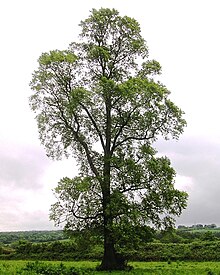Smooth-leaved Elm
| Ulmus minor subsp. minor | |
|---|---|
 |
|
| Smooth-leafed Elm at East Coker, Somerset, 2008 | |
| Scientific classification | |
| Kingdom: | Plantae |
| (unranked): | Angiosperms |
| (unranked): | Eudicots |
| (unranked): | Rosids |
| Order: | Rosales |
| Family: | Ulmaceae |
| Genus: | Ulmus |
| Species: | U. minor |
| Subspecies: | U. minor subsp. minor |
| Trinomial name | |
|
Ulmus minor subsp. minor Richens |
|
| Synonyms | |
|
|
Ulmus minor subsp. minor Richens, the Smooth-leaved Elm, Narrow-leafed Elm or East Anglian Elm, is a subspecies of the Field Elm native to southern Europe and Asia Minor including Iran.
The name Ulmus minor subsp. minor was used by R. H. Richens for Field Elm that was not English Elm, Cornish Elm, Lock Elm or Guernsey Elm. Many publications, however, continue to use plain Ulmus minor for Richens's Ulmus minor subsp. minor. Indeed Dr Max Coleman of Royal Botanic Garden Edinburgh argued in his 2002 paper 'British Elms' that there was no clear distinction between species and subspecies.
The Smooth-leaved Elm is a deciduous tree that can grow to 35 m. Its Latin synonym carpinifolia alludes to the superficial similarity of the leaves to those of Hornbeam Carpinus sp., while the common names contrast the smooth upper surface and narrowness of the leaves with those of the Wych Elm, which are rough and broad. The apetalous perfect wind-pollinated flowers, and fruit (samarae) are very similar to those of the species.
Although the Smooth-leafed Elm is generally susceptible to Dutch elm disease, it is genetically a highly variable tree and it is possible some specimens survive in the UK owing to an innately high level of resistance (see Cultivation). Research currently (2009) in hand by Cemagref at Le Pepiniére forestiére de l’Etat, Guémené-Penfao, France, should confirm this. However, all Smooth-leafed Elm varieties are believed to have been introduced into Britain from central and southern Europe during the Bronze Age, and some, being beyond their natural climates and environments, may be growing slowly and thus producing smaller springwood vessels restrictive to the Ophiostoma fungus. Good performance in the field may also be owing to resistance to bark beetle feeding or breeding. Moreover, several types of this subspecies also have very pendulous twigs when mature, a factor which could also make them unattractive to foraging Scolytus beetles, which are disinclined to invert themselves.
...
Wikipedia
